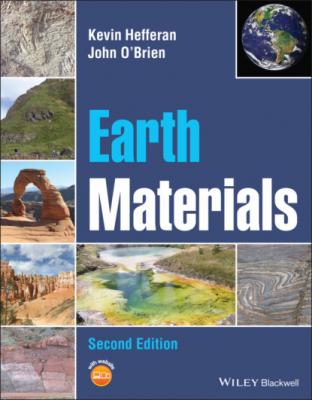Earth Materials. John O'Brien
Читать онлайн.| Название | Earth Materials |
|---|---|
| Автор произведения | John O'Brien |
| Жанр | География |
| Серия | |
| Издательство | География |
| Год выпуска | 0 |
| isbn | 9781119512219 |
4.8 CRYSTAL DEFECTS
Ideally, crystals are perfectly formed with no defects in their lattice structures (Figure 4.32a). However, nearly all crystals contain small‐scale impurities or imperfections that cause mineral composition and/or structure to vary from the ideal. These local‐scale inhomogeneities are called crystal defects. Crystal defects have some profound effects on the properties of crystalline material that belie their small scale (Box 4.1). A convenient way to classify crystal defects is in terms of their dimensions.
Box 4.1 Frenkel and Schottky defects
Frenkel defects (Figure B4.1a) are formed when the ions in question move to an interstitial site, leaving unoccupied structural sites or holes behind. Frenkel defects combine omission and interstitial defects. Because the ion has simply moved to another location, the overall charge balance of the crystal is maintained, but local lattice distortions occur in the vicinities of both the holes and the extra ions. Schottky defects (Figure B4.1b) are omissions formed when the ions migrate out of the crystal structure or were never there. Schottky defects create a charge imbalance in the crystal lattice. Such charge imbalances may be balanced by the creation of a second hole in the crystal structure; for example, an anion omission may be created to balance a cation omission. They may also be balanced by the substitution of ions of appropriate charge difference elsewhere in the structure. The highly magnetic mineral pyrrhotite (Fe1–XS) provides a good example. When a ferrous iron (Fe+2) ion is omitted from a cation site in the crystal structure, leaving a charge deficit of 2, two ferric iron (Fe+3) ions can substitute for ferrous iron (Fe+2) ions to increase the charge by 2 and produce an electrically neutral lattice (Figure B4.1b). The formula for pyrrhotite (Fe1‐xS) reflects the fact that there are fewer iron (total Fe+2 and Fe+3) ions than sulfur (S−2) ions in the crystal structure due to the existence of a substantial number of such Schottky omission defects.
Point defects can occur on still smaller scales. In some cases electrons are missing from a quantum level, which produces an electron hole in the crystal structure. In others, an electron substitutes for an anion in the crystal structure. As with other point defects, the existence of electron holes plays an important role in the properties of the crystalline materials in which they occur. In most minerals, as temperature increases, the number of omission defects tends to increase. This allows minerals to deform more readily in a plastic manner at higher temperatures.
Figure B4.1 (a) Frenkel defect, with a vacancy due to an ion displaced to the interstitial site. (b) Shottky defect in pyrrhotite (Fe1–xS) where a vacancy (absent Fe+2) is balanced by the substitution of Fe+3 for Fe+2 in two lattice sites.
4.8.1 Point defects
Point defects involve individual atoms and therefore do not have longer range extent; they are considered to be zero‐dimensional defects. Many types of point defects exist, and they are important in explaining the properties of minerals as well as other materials that include steel, cement, glass products, semiconductors, and superconductors. These include the following:
1 Substitution defects (Figure 4.32b) form when anomalous ions of inappropriate size and/or charge substitute for ions of appropriate size and/or charge in a structural site. These anomalous ions tend to distort the crystal lattice locally and to be somewhat randomly distributed within the crystal lattice.
2 Interstitial defects (Figure 4.32c) occur when anomalous ions occupy the spaces between structural sites. Such “extra” ions are trapped in the interstices between the “normal” locations of ions in the crystal lattice.
3 Omission defects (Figure 4.32d) form when structural sites that should contain ions are unoccupied. In such cases, ions that should occur within the ideal crystal structure are omitted from the crystal lattice leaving a “hole” in the ideal crystal structure.
4.8.2 Line defects
Line defects are called dislocations. As lines, they possess extent in one direction and are therefore one‐dimensional defects. Dislocations commonly result from shearing stresses produced in crystals during deformation. These stresses cause atomic planes to shift position, producing distortions in the crystal lattice that can be represented by a line called a dislocation line. Two major types of dislocations are recognized: edge dislocations (Figure 4.33a) and screw dislocations (Figure 4.33b).
Figure 4.32 (a) Perfect crystal lattice; (b) substitution defect; (c) interstitial defect; (d) omission defect.
Figure 4.33 (a) Edge dislocation with an extra half plane of atoms; this is a line defect because the base of the half plane can be represented by a dislocation line (⊥). (b) Screw dislocation, where a plane of atoms has been rotated relative to the adjacent plane.
Source: Klein and Hurlbut (1985). © John Wiley & Sons.
Dislocations are extremely important in the plastic deformation of crystalline materials that leads to changes in rock shape and volume without macroscopic fracturing. Dislocations permit rocks to flow plastically at very slow rates over long periods of time. Detailed discussions are available in many books on mineralogy (e.g., Wenk and Bulakh 2016) and structural geology (e.g., van der Pluijm and Marshak 2004; Davis et al. 2011). Figure 4.34 shows how an edge dislocation can migrate through a crystal by breaking a single bond at a time. The result of dislocation migration is a crystal shape change accomplished without rupture. Dislocations are important plastic deformation processes allowing rocks to change shape without visible rupture (Chapter 16).
